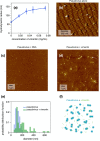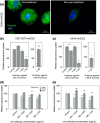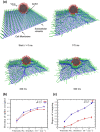This is a preprint.
Extracellular vimentin as a target against SARS-CoV-2 host cell invasion
- PMID: 33442680
- PMCID: PMC7805437
- DOI: 10.1101/2021.01.08.425793
Extracellular vimentin as a target against SARS-CoV-2 host cell invasion
Update in
-
Extracellular Vimentin as a Target Against SARS-CoV-2 Host Cell Invasion.Small. 2022 Feb;18(6):e2105640. doi: 10.1002/smll.202105640. Epub 2021 Dec 5. Small. 2022. PMID: 34866333 Free PMC article.
Abstract
Infection of human cells by pathogens, including SARS-CoV-2, typically proceeds by cell surface binding to a crucial receptor. In the case of SARS-CoV-2, angiotensin-converting enzyme 2 (ACE2) has been identified as a necessary receptor, but not all ACE2-expressing cells are equally infected, suggesting that other extracellular factors are involved in host cell invasion by SARS-CoV-2. Vimentin is an intermediate filament protein that is increasingly recognized as being present on the extracellular surface of a subset of cell types, where it can bind to and facilitate pathogens' cellular uptake. Here, we present evidence that extracellular vimentin might act as a critical component of the SARS-CoV-2 spike protein-ACE2 complex in mediating SARS-CoV-2 cell entry. We demonstrate direct binding between vimentin and SARS-CoV-2 pseudovirus coated with the SARS-CoV-2 spike protein and show that antibodies against vimentin block in vitro SARS-CoV-2 pseudovirus infection of ACE2-expressing cells. Our results suggest new therapeutic strategies for preventing and slowing SARS-CoV-2 infection, focusing on targeting cell host surface vimentin.
Conflict of interest statement
Competing Interests: The authors declare no competing interests.
Figures







Similar articles
-
Extracellular Vimentin as a Target Against SARS-CoV-2 Host Cell Invasion.Small. 2022 Feb;18(6):e2105640. doi: 10.1002/smll.202105640. Epub 2021 Dec 5. Small. 2022. PMID: 34866333 Free PMC article.
-
Extracellular vimentin is an attachment factor that facilitates SARS-CoV-2 entry into human endothelial cells.Proc Natl Acad Sci U S A. 2022 Feb 8;119(6):e2113874119. doi: 10.1073/pnas.2113874119. Proc Natl Acad Sci U S A. 2022. PMID: 35078919 Free PMC article.
-
Surface vimentin is critical for the cell entry of SARS-CoV.J Biomed Sci. 2016 Jan 22;23:14. doi: 10.1186/s12929-016-0234-7. J Biomed Sci. 2016. PMID: 26801988 Free PMC article.
-
Host-Cell Surface Binding Targets in SARS-CoV-2 for Drug Design.Curr Pharm Des. 2022;28(45):3583-3591. doi: 10.2174/1381612829666221123111849. Curr Pharm Des. 2022. PMID: 36420875 Review.
-
Targeting the viral-entry facilitators of SARS-CoV-2 as a therapeutic strategy in COVID-19.J Med Virol. 2021 Sep;93(9):5260-5276. doi: 10.1002/jmv.27019. Epub 2021 May 3. J Med Virol. 2021. PMID: 33851732 Free PMC article. Review.
Cited by
-
Cell surface detection of vimentin, ACE2 and SARS-CoV-2 Spike proteins reveals selective colocalization at primary cilia.Sci Rep. 2022 Apr 29;12(1):7063. doi: 10.1038/s41598-022-11248-y. Sci Rep. 2022. PMID: 35487944 Free PMC article.
References
Publication types
Grants and funding
LinkOut - more resources
Full Text Sources
Other Literature Sources
Miscellaneous
